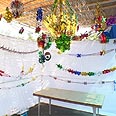
From s'chach to etrog: Sukkot laws
What can one eat outside sukkah? Who holds Four Species? Can one travel to a place where there is no sukkah during holiday? Rabbi Shmuel Shapira answers all your questions
What are the conditions for a kosher sukkah?
First of all, the sukkah must have four strong and steady walls. In case of swinging straps, stretch branches or threads less than 24 centimeters (9.5 inches) apart, up to 80-centimeters (31.5-inches) high (about four-five threads).
Can s'cach be placed on wooden pergola?
The sukkah must be covered with a kosher s'cach, which should be placed on wood, not on the metal structure. Several branches should be placed above the s'cach to prevent it from flying with the wind. One must not place a roof or tree underneath.
The s'cach may be placed above a wooden pergola, as long as the gaps between the rails are bigger than the width of the rails (in other words, so that most of the net won't be shaded).
When part of the sukkah has a roof over it – one must inquire in which cases it is kosher. In any event, men must not sit under the roof.
How does one observe mitzvah of sitting in sukkah?
On the first night, one must eat in the sukkah and say the blessing on all major meals. Ashkenazim say the blessing on cakes and wine as well. Drinking soft drinks and eating fruit and vegetables does not require sitting in the sukkah. Sleeping in the sukkah is a mitzvah, even temporary sleep.
Can one travel to place without a sukkah?
Travelers are exempt of the sukkah obligation. Some say the exemption is for necessary trips, not excursions, so one would be advised to plan one's trips to a place with a sukkah. A sukkah can be built on the intermediary days of the holiday if necessary. It can also be built on a vehicle, and today there are sukkot which can be dismantled and are easy to carry from place to place and assemble.
What are the principles for kashrut of Four Species?
Lulav (palm frond): Must be at least 32-centimeters (12.5-inches) long, straight with closed leaves and not bent or broken at the top.
Etrog (citron): Not complicated. Must be smooth (without holes), without spots and not black. The cleaner and flawless it is, especially at the top – the more elegant.
Hadass (myrtle branch): Take three branches, measuring at least 24 centimeters (9.5 inches). Most leaves must be triangle (in other words, three leaves departing from one point).
Aravah (willow branch): Two branches, each measuring 24 centimeters (9.5 inches). Must not be withered, especially not during the last days of the holiday. If withered – replace them with fresh and damp branches.
How does one observe Four Species mitzvah?
Take the Three Species (the lulav, hadass and aravah) and bind them together. The holder they are placed in is considered one binding, and the bundle may be bound with strips from another lulav. Sephardim decorate the lulav with threads and other bindings not woven from palm fronds.
The waving is done standing up, with the lulav in the right hand and the etrog in the left hand, facing downward. After the prayer is said, the etrog is turned over. Women are exempt, but usually hold the lulav, and Ashkenazi women also say the prayer.
Waving the lulav: It is waved after the blessing, and the recital of Hallel. There are several waving customs – the Ashkenazi and Sephardic versions: East, south, west, north, up and down. Three times in each direction.
Chag Sameach from Kochav Yair Rabbi Shmuel Shapira!
For inquiries and questions on halachic issues, contact Tzohar's call center on Sundays to Thursday, 7-11 pm, at 1-800-200-377
- Follow Ynetnews on Facebook










